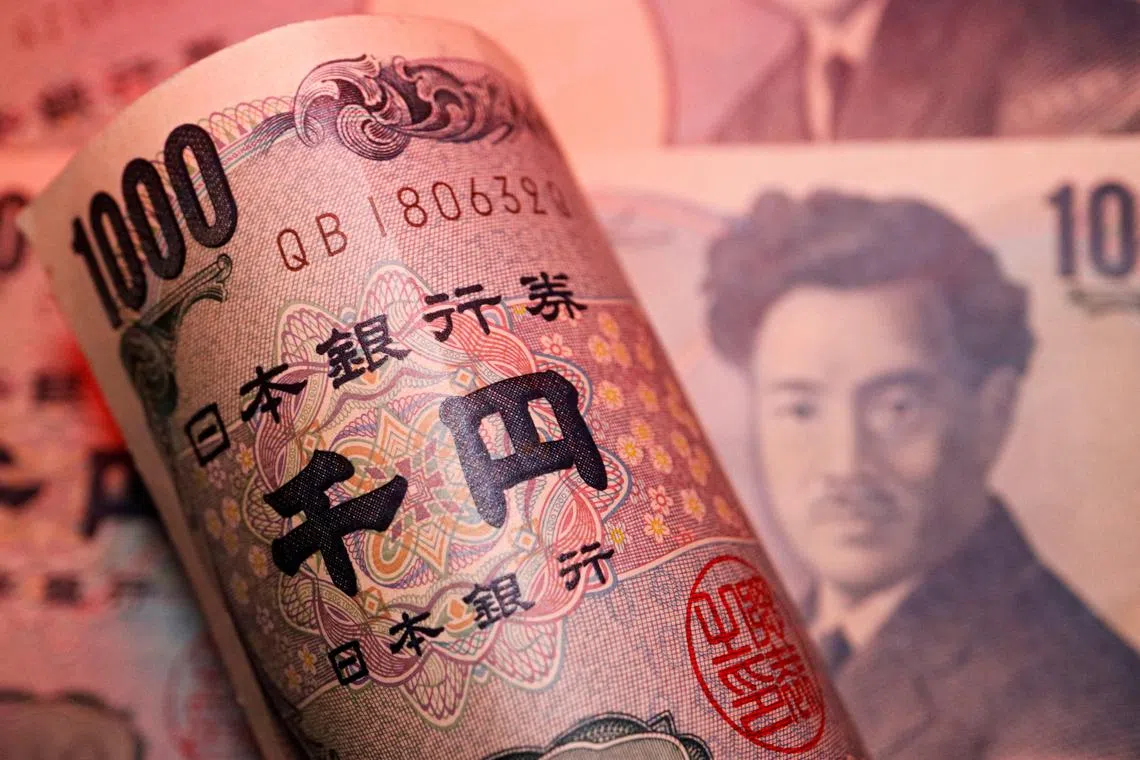Yen speculators bow to Japan’s stealth strategy
Sign up now: Get ST's newsletters delivered to your inbox

The yen has held on to a large chunk of its gains following Japan’s record US$43 billion (S$60.3 billion) spend last month.
PHOTO: REUTERS
Follow topic:
TOKYO – Japan is enjoying some success in its battle with speculators targeting the enfeebled yen and the central bank’s stubborn grip on yields, but more tests lie ahead.
After months of talking turned into concrete action in the foreign exchange market, speculative positioning has been pegged back at least in the currency space. Together with a favourable reduction in demand for the greenback, this has kept the yen well away from the key 150 per dollar mark in recent weeks.
“Japan’s authorities are not likely letting their guard down, but it is looking increasingly likely that they have persevered and pulled themselves out of the woods,” said chief market analyst Jun Kato at Shinkin Asset Management in Tokyo. “They have also gotten lucky with the external environment, which seems to be changing.”
Unannounced currency intervention, ramped-up bond buying and an extra budget have helped Japan show financial markets that it is standing its ground on stimulus, even as the rest of the world tightens policy. But investors are well aware that it stands alone, especially in the currency market, where peers like the United States have refused to explicitly endorse its intervention policy.
Market reaction to US consumer price figures will provide further evidence that Japan has played its cards relatively well, or reveal that the recent calm was merely a prelude to a fresh storm. A stronger-than-expected result could drive yen weakness, leading traders to price in even more US rate increases, while a softer reading may have the opposite effect.
“If (the consumer price index) continues to be very strong, the dollar may rise again, but it is hard to see the US economy enduring rate hikes up to 5.25 per cent,” Mr Kato said. “The probability is rising that the recent dollar-yen high of 151.95 may be seen in retrospect as the peak.”
The yen has held on to a large chunk of its gains following Japan’s record US$43 billion (S$60.3 billion) spend in October, when the currency looked like it was breaching 152. Since then, it has weathered both another dovish decision by the Bank of Japan (BOJ) and a further outsized rate increase by the US Federal Reserve, events speculators had previously jumped on as an excuse to sell the currency.
It traded around the 146.1 level on Thursday.
“If you ask me whether Japan has had some success with its forex interventions, I would say yes,” said executive economist Hideo Kumano at Dai-Ichi Life Research Institute. “The interventions on Oct 21 and 24 went well in that the authorities moved early because they knew the impact would be weaker if they waited until the Fed meeting.”
By staying silent on whether they have entered markets since their first intervention in September, the Japanese authorities have kept traders partly in the dark over their plans. Apparent action has also generally taken place outside Tokyo hours to show foreign traders they do not have a free rein to attack.
A combination of large interventions and possible stealth moves is resulting in a cheaper bill than many economists expected. The use of foreign securities to fund yen buying instead of cash deposits also looks like a calculated move to show that the firepower Tokyo has immediately at hand is far larger than its simple stash of greenback.
“Japan is trying to send a strong message that it has ample resources to intervene,” said currency strategist Yuji Yamazaki at SMBC Nikko Securities.
Mr Yamazaki, along with some other economists, believes Japan has been selling Treasuries despite earlier scepticism that such action might raise Washington’s ire and result in a self-defeating rise in US yields that renews pressure on the yen.
Market data also points to some success. A gauge of option market bets on outsized moves in the currency over the short term – so-called one-month butterflies – has fallen for 13 straight days to the lowest since August.
Paradoxically, bets by some investors that the market can pressure the BOJ to break ranks has most likely helped to bolster the yen. Despite the central bank’s insistence that it will stick with its 0.25 per cent cap on 10-year debt, swap markets still point to a tweak, possibly around the time that bank governor Haruhiko Kuroda steps down in April.
Even a small signal from the central bank that it is contemplating dialling back its easy policy is likely to lead to a yen rally, according to market participants. For its part, the BOJ will point to a fall-off in the amount it is spending to defend the yield cap – fixed-rate bond purchases hit a record during the speculative attacks on the market in June.
For now, it looks like Japanese policymakers have bought enough time without having to buckle to market pressure. A change in the Fed policy path has long been seen as the key moment that will turn the tide for the yen, and Fed chairman Jerome Powell’s signalling of smaller rate increases earlier in November may have provided that moment.
Still, Mr Powell also flagged that US rates could end up higher than markets think, a classic central banker’s ploy of offering something for both sides of the argument.
“That means it will take time to reach the final phase of rate hikes,” said chief FX strategist Osamu Takashima at Citigroup Global Markets Japan. “And that means the period of uncertainty will be prolonged.”
BLOOMBERG

